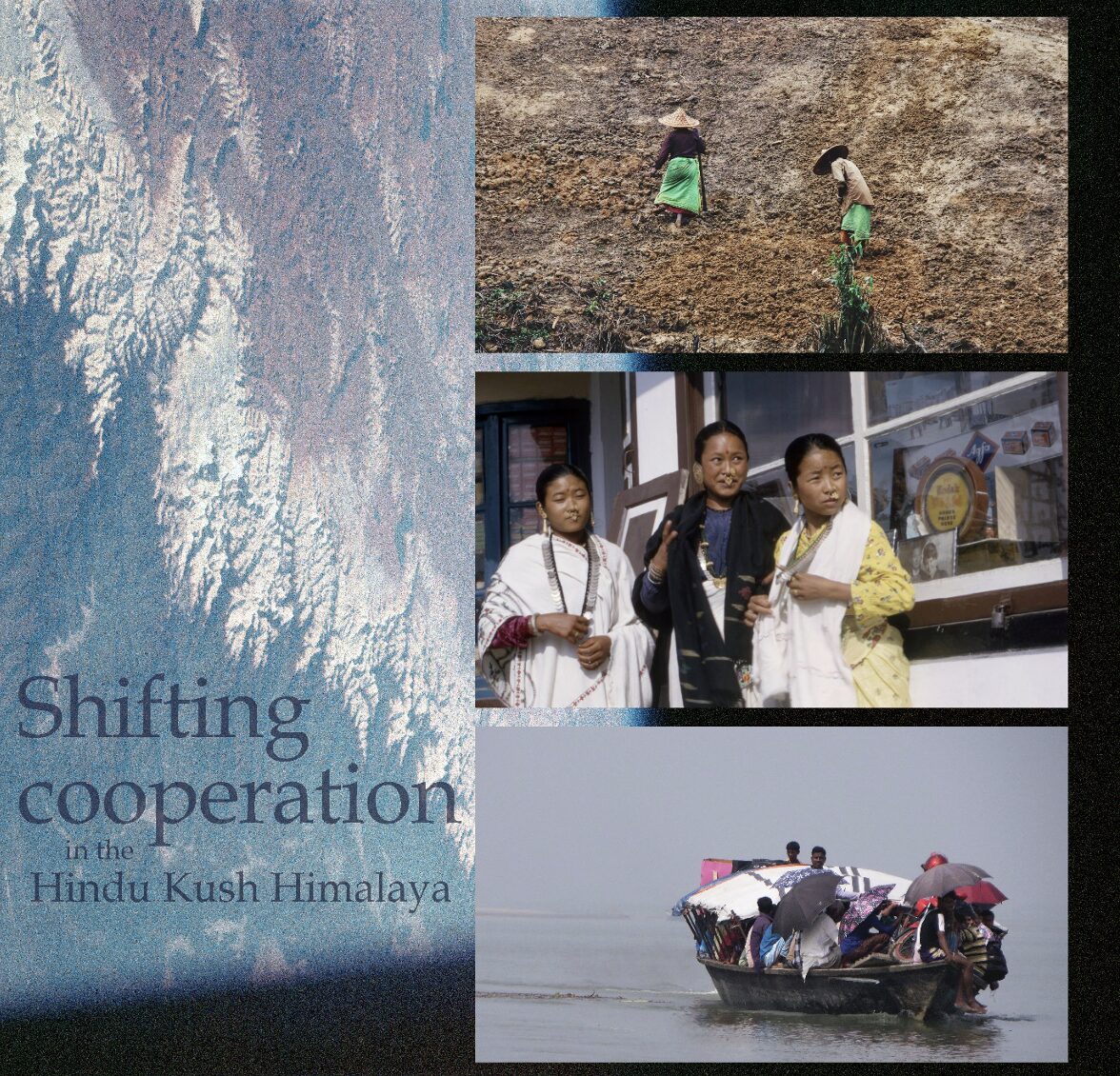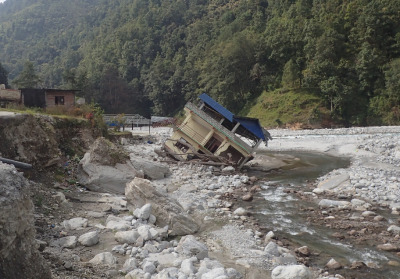A roadmap for regional cooperation on adaptation in the Hindu Kush Himalaya: addressing transboundary and cascading climate risks

The context
As global temperatures rise, and the severity and frequency of extreme events increase, countries are vulnerable to the risks from within their own borders and those catalysed by cascading and spillover effects from the impacts of climate change farther afield – sometimes from places on the other side of the world. How will these risks spread? Who will be affected? The answers depend to a large degree on dynamic networks of people, finance, resources, and trade.
The HKH region spans eight countries – Afghanistan, Bangladesh, Bhutan, China, India, Myanmar, Nepal and Pakistan – and is home to twelve major rivers, seven of which are transboundary. Its ecosystems provide direct services – such as freshwater resources – to 240 million people living within the region and support a further 1.65 billion people downstream. This makes the mountains of the HKH a globally important asset.
The region is also financially and socially integrated with the rest of the world. This means that the economic aspirations of its governments and the welfare and security of its people depend on the successful management of climate change impacts in any number of countries, across all regions of the world. These growing interdependencies mean the HKH faces significant risks from climate change both direct and indirect in nature.
Demonstrating that regional adaptation among the countries of the HKH supports and strengthens global resilience to climate change could command significant attention on the world stage.
This article is an abridged version of the original text, which can be downloaded from the right-hand column. Please access the original text for more detail, research purposes, full references, or to quote text.
Transboundary climate risks and their manifestation in the HKH
Transboundary climate risks are generated when the impacts of climate change or mitigation and adaptation actions cross administrative boundaries or national borders and result in adverse effects in a jurisdiction beyond their inception. Such risks are already manifesting across the HKH via intra-regional risks (risks that both originate and manifest within the HKH), endogenous risks (risks that originate in the HKH but manifest for people beyond the region) and exogenous risks (risks that originate from beyond the HKH but manifest within the region). Such risks could increase in severity in the future as the climate warms and the effects propagate through different spheres of activity:
- Energy security – Climate change can impact the production, supply and distribution of energy and the infrastructure on which all these depend. Disruptions can create cascading impacts that propagate through export-import relationships (see p.7 for examples from the HKH region).
- Trade, finance and infrastructure – Climate change can impact the export and import of food and other commodities (including those essential for manufacturing industries), the resilience of international financial investments and remittances, and the infrastructure underpinning these economic sectors (see p.8 for examples from the HKH region).
- Human health and wellbeing -The cascading effects of climate change in one country can generate and amplify risks to the physical and mental wellbeing of people in another. Climate-sensitive infectious diseases are a growing global concern. Climate impacts can also disrupt critical health infrastructure and pharmaceutical supply chains that are vital for the supply of essential medicines (see p.8 for examples from the HKH region).
- Biodiversity and ecosystem services – Cascading climate impacts can generate risks to ecosystems and biodiversity and the services they provide through increasing numbers of invasive species, geographic redistributions of flora and fauna, and diseases in plants and animals. Wildlife corridors, tourism infrastructure, water basins, and protected areas can all be transboundary in nature, providing a vehicle through which climate risks can transcend political and sectoral boundaries (see p.9 for examples from the HKH region).
Regional cooperation in the HKH
In 2023, the Adaptation Without Borders partnership convened a group of 45 regional stakeholders in a science-policy dialogue on regional cooperation on adaptation to cascading climate risks in the HKH. The dialogue aimed to identify what a regional institutional mechanism could feasibly and usefully do to strengthen cooperation on adaptation to cascading climate risks, the main areas of work it could advance, and the tangible outcomes it could and should deliver. A key recommendation from the dialogue was to establish a crosscutting working group on adaptation in mountain areas to drive regional resilience to cascading climate risks. This working group would work with other thematic working groups established under the regional institutional mechanism – on the cryosphere and air pollution, for example – to ensure an integrated and coherent approach. Participants also proposed a roadmap of actions to be considered and coordinated by such a working group.
Building on up-to-date analysis, we group these actions into three types: 1) research, information sharing, knowledge-based dialogue; 2) policy and governance instruments; and 3) implementation, capacity strengthening and finance.

The Roadmap
Research, information sharing, and knowledge-based dialogue
Adequately addressing transboundary climate risks requires research and data collection, the sharing of information and insights, and dialogues between sectors and across scales. This roadmap calls for five actions and measures to support and enhance research, information sharing, and knowledge-based dialogues on transboundary climate risks in the HKH:
- Establish a Hindu Kush Body of Experts on Climate Change (HKCC) and equip them with a mandate to strengthen the evidence base on transboundary climate risks that the region faces.
- Commission collaborative and multidisciplinary research on transboundary climate risks in four sequential areas: a regional transboundary climate risk assessment; a series of deep-dive case studies; a political-economy analysis; a cost-benefit analysis of investing in adaptation to address cascading climate risks.
- Examine the feasibility of establishing a regional information service, led by a multi-stakeholder network of climate scientists and service providers, to incentivize investment in data collection and exchange on transboundary climate risks in real-time.
- Integrate transboundary climate risks into national risk assessments.
- Commission assessments of best practices and responses in building resilience to cascading climate risks and share results in a common repository.
To explore these actions in more detail, please refer to pages 16-17.
Policy and governance instruments
The 2023 UN Climate Change Conference took a decisive step towards creating a more effective enabling environment for the management of transboundary and cascading climate risks globally. But such recognition now needs to be reflected in stronger risk management practices of governments the world over – including those in the HKH. This roadmap calls for four actions and measures to support and enhance the governance of transboundary climate risks in the HKH:
- Establish a regional adaptation framework.
- Convene a regional climate summit.
- Coordinate inter-ministerial and inter-departmental exchanges.
- Instigate or support a group of mountain negotiators under the UNFCCC.
To explore these actions in more detail, please refer to pages 20-21.
Implementation, capacity strengthening, and finance
The IPCC (2023) has recognized that “weather and climate extremes are causing economic and societal impacts across national boundaries through supply-chains, markets, and natural resource flows, with increasing transboundary risks projected across the water, energy and food sectors”. However, governments and organizations aiming to implement adaptation to such cascading risks face three significant and related hurdles: lack of evidence, lack of capacity and lack of finance. This roadmap calls for six actions and measures to facilitate implementation, strengthen capacities, and mobilize climate finance in relation to adaptation to transboundary climate risks:
- Develop a regional adaptation implementation framework to guide the operationalization of programs to address transboundary climate risks.
- Scope the needs, costs and benefits of an HKH Community-Based Early Warning System (HKH – CBEWS) to strengthen access to information about transboundary climate risks.
- Develop a comprehensive and long-term, regional capacity-strengthening program on the management of transboundary climate risks.
- Establish a regional climate adaptation fund dedicated to managing transboundary climate risks.
- Enhance the enabling environment for multilateral climate finance to better address transboundary climate risks in the HKH.
- Host investment dialogues to fund adaptation projects and programs in key sectors affected by transboundary climate risks.
To explore these actions in more detail, please refer to pages 24-25.
Suggested Citation
Adaptation Without Borders (2024). A roadmap for regional cooperation on adaptation in the Hindu Kush Himalaya: addressing transboundary and cascading climate risks. Stockholm Environment Institute, Stockholm.






Comments
There is no contentYou must be logged in to reply.